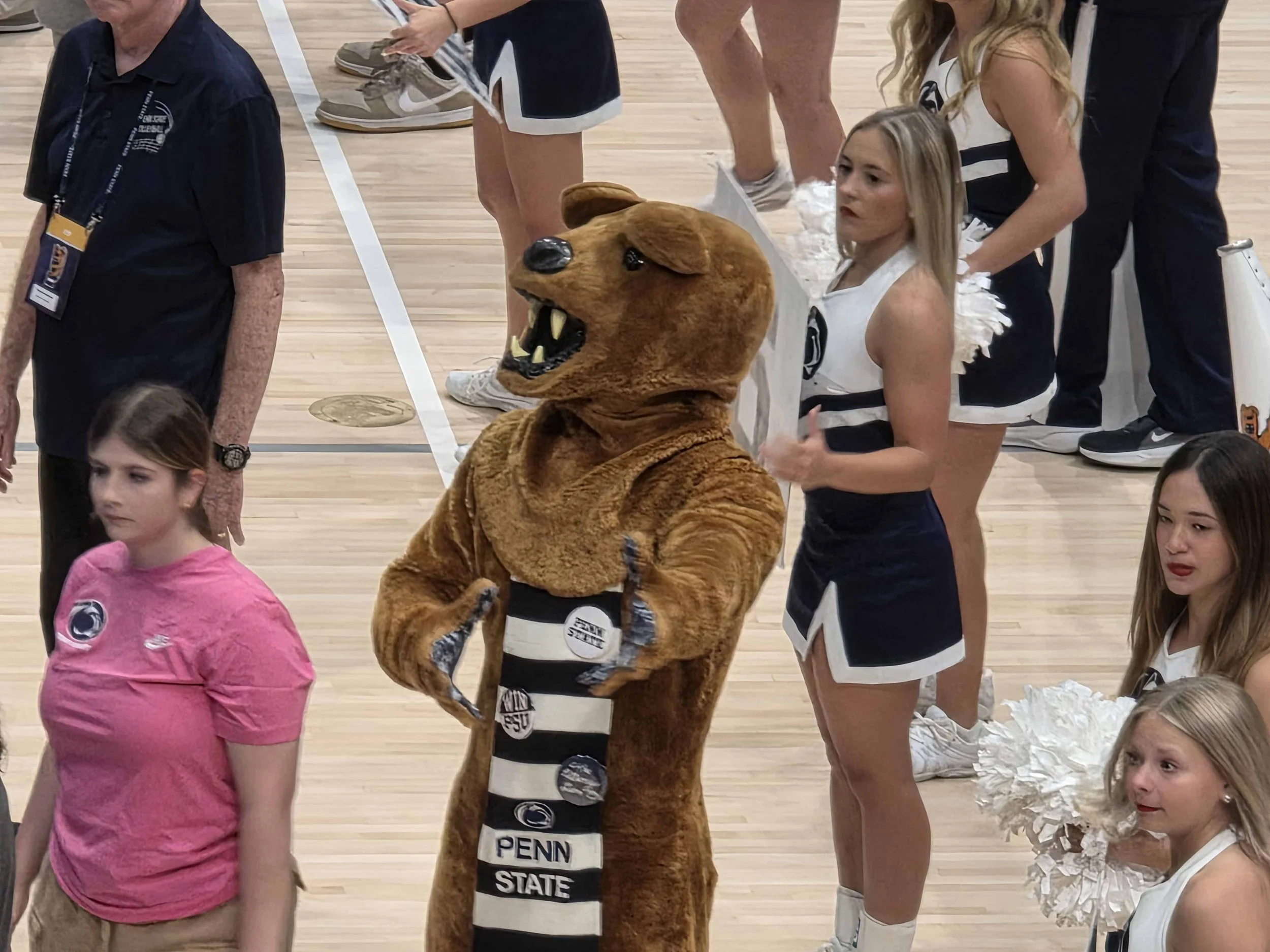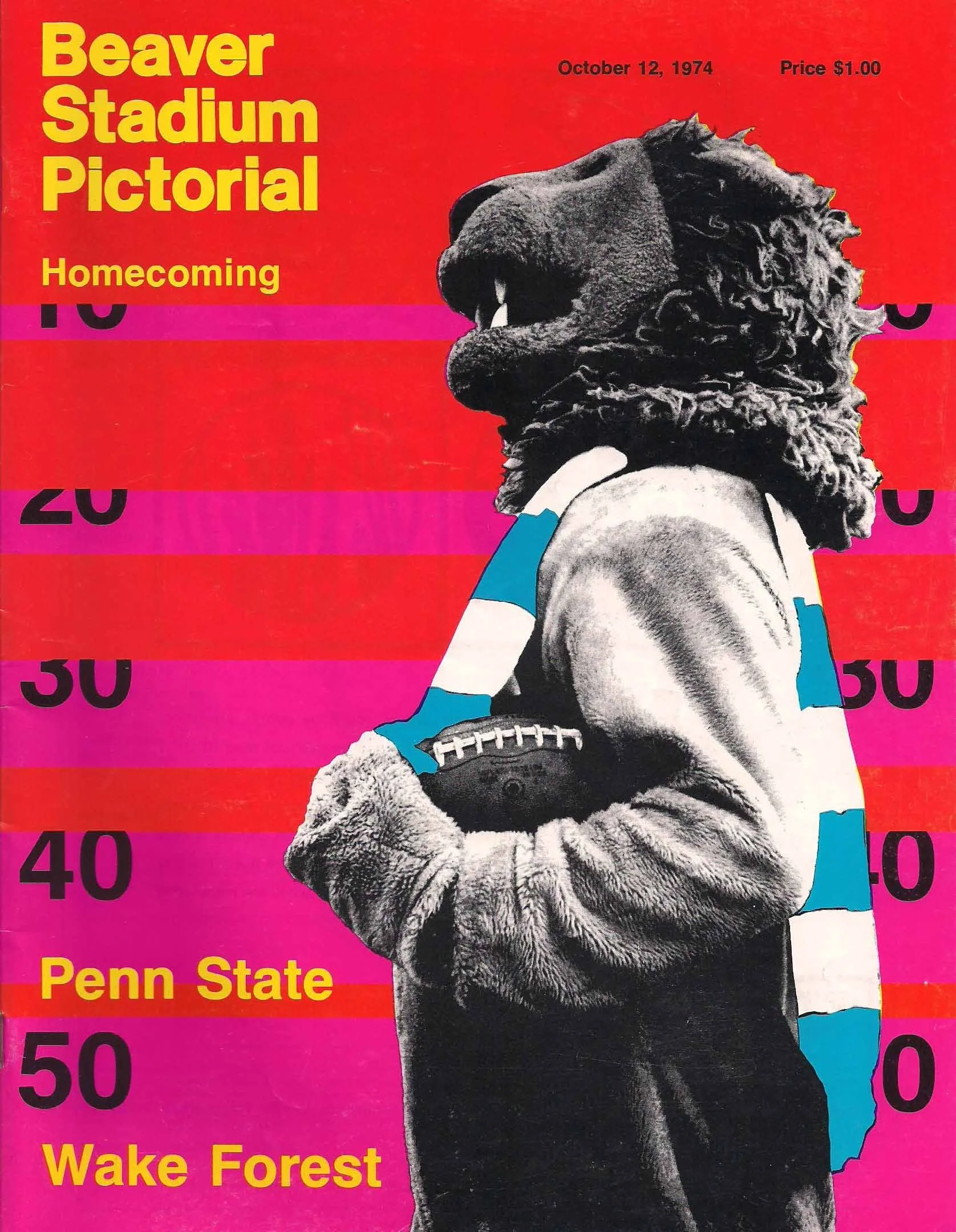
The Nittany Lion
The Nittany Lion Mascot—
The popular Nittany Lion Mascot, a student in a lion costume, dates to the 1922 football season where it debuted and very nearly ended. The student wearing an African lion (with a full mane) costume first appeared publicly at the 1922 Syracuse game which was played at the Polo Grounds in New York City (this story is supported by a photo with caption on display at the All-Sports Museum). There is also photo evidence of the same African lion mascot with the so-called “Chain Gang and their dog mascot” at the 1922 game against Navy in what was known as American League Park in Washington, DC. This lion may have also appeared at other games late that fall (see photo below). NOTE: There are some stories suggesting that this lion may have first appeared at the 1921 game at the Polo Grounds vs. Georgia Tech, but there is no known photo evidence of that, and it might simply be a confusion of the two games played in New York.
The African lion costume itself was borrowed from the student theatre group known as the Penn State Players that had staged the production of “Androcles and the Lion” at Schwab Auditorium in November of 1920. Because it was supposed to be a “real” lion, the student in the suit walked around on all four legs. The guy in the costume was Richard Hoffman of the Class of 1923. He played the role of the lion in the play, and sort of took the show “on the road”. In a 1977 article in Penn Stater magazine, Hoffman was said to have a very strong voice and could “quote” roar like a lion which he did at the games he attended.
So, what happened to the four-legged African lion mascot? Well, the most probable story is that Penn State Head Coach Hugo Bezdek (1918-29) thought the lion was bad luck. Bezdek reportedly banished the lion from games after Penn State, which had already been invited to the 1923 Rose Bowl, began to lose with it on the sidelines. State had opened the ‘22 football season winning its first five games, but the Syracuse game was a scoreless tie and Penn State would close the regular season on a 1-3-1 run in the five games after the mascot first appeared (the losses were to Navy, UPenn & Pitt). And, the Rose Bowl game vs. USC, which the lion did not attend, was a loss, too. There’s some indication that the four-legged lion mascot may have re-surfaced in the 1927 season (6-2-1), but it disappeared again, this time for good as far as Bezdek was concerned.
The two-legged version of the lion mascot that we know today first appeared in the 1939 season. Penn State gymnast, later legendary gymnastics coach, Gene Wettstone along with 2 other gymnasts revived the “student in a lion costume” giving it more of a modern mascot, less real lion, feel. It was also the first mountain lion costume without a mane. Wettstone is also said to have trained the students who would follow him and the tradition was born. The Nittany Lion Mascot has been through a number of modifications over the years notably switching from a cartoonish head to a more real looking lion head and switching between styles with and without a “small mane”. By the way, the style with the mane has not been seen since the 1975 football season. Supposedly, the Nittany Lion Mascot has appeared, at least, at all homes since 1939 except for one game in 1947 where the suit was said to be in such disrepair that the athletic department did not have the funds to fix it. That seems hard to believe now.
Since 1976, the modern lion “without a mane” mascot has undergone some modifications to its look. Notably, by adding a black screen in the mouth behind the teeth to hide the student inside the costume more effectively. It was said that young children were frightened by the mascot because they could see the person inside the outfit and thought the lion had swallowed him.
The two images below from the late 70’s feature legendary Nittany Lion mascot Norm Constantine (1978-80).
Interesting facts about the Nittany Lion Mascot from Penn Stater magazine—
Push-ups after PSU scores are said to have begun in the 1965-67 range.
One-armed push-ups were debuted by mascot Danny Kohlhepp at a victory rally following the 1969 Orange Bowl win over Kansas and then carried into the 1969 football season by new mascot, David Lacey.
The record for one-armed push-ups in a single game is 543 by mascot Tim Durant at the 1991 Cincinnati game which ended in an 81-0 Penn State victory.
CLICK HERE FOR THE INTERESTING HISTORY OF NITTANY LION SHRINE VANDALISM
CLICK HERE FOR THE HISTORY OF NITTANY LION LOGOS
Nittany Notes:
Generally speaking, the Nittany Lion Mascot costume should never be worn by anyone who is not serving in the role of the mascot at the time. But there have been some exceptions.
In the summer of 1974, folks in the PSU athletic department were planning the covers for the upcoming season of Beaver Stadium Pictorial game day programs. Sports Information employee, and former Penn State art student, Joe Kredlow helped design the covers and he had an idea that required the Nittany Lion Mascot for a photo shoot. Problem was that the student who played the Lion was away for the entire summer. Bob Welsh, a member of the wrestling team who served 2 years in the role, was with the World Football League’s Chicago Fire helping with ticket sales and public relations. This didn’t stop Kredlow who said he got the suit out of storage and put it on for the photo session which yielded the primary cover art for the 1974 Wake Forest game program (see below). FYI-That same photo was also used 4 weeks earlier as part of a photo collage on the cover of the 1974 Stanford game BSP.
In those days, Joe Paterno had final say on all Beaver Stadium Pictorial covers. Paterno approved the Wake Forest cover. But, Kredlow said that Joe later found out that Welsh was not in the suit for the photo and “he was not pleased”. Paterno told Kredlow that he was never to do that again. For the record, Kredlow said that the suit smelled terrible on the inside, as you might expect, and he was happy never to wear it again.





